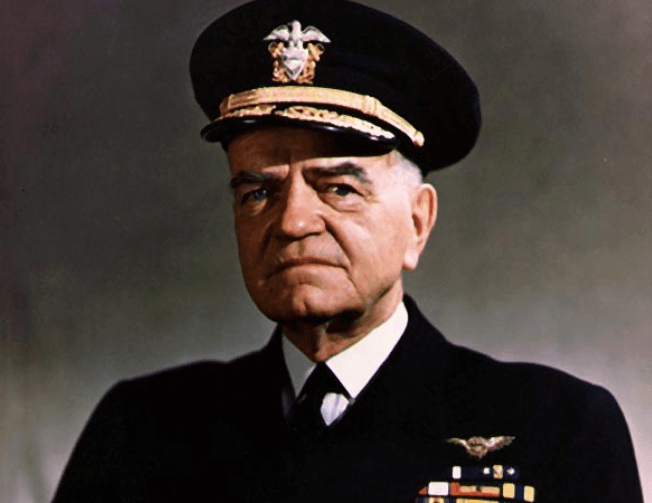Who was William Halsey Jr.? Information on American fleet admiral William Halsey Jr. biography, life story and military career.

Source: wikipedia.org
William Halsey, Jr.; (1882-1959), American fleet admiral, who defeated the Japanese in many battles of World War II and played a vital part in securing Allied victory. He was born in Elizabeth. N. J., on Oct. 30, 1882, and graduated in 1904 from the U. S. Naval Academy.
As a midshipman, Halsey began his seagoing career on the U. S. S. Missouri, the “Mizzy.” At the end of World War II his flagship was another Missouri, the “Mighty Mo,” on which the formal Japanese surrender was signed.
During World War I, he commanded destroyere engaged in patrol and convoy escort duty and received a Navy Cross. Between World Wars I and II he commanded successively groups of destroyere, the aireraft carrier Saratoga, the naval air station at Pensacola, Fla., groups of carriers, and groups of aireraft. He attended the Naval War College in 1933 and the Army War College in 1934. At 52 he won the wings of a naval aviator.
World War II.
When the Japanese attacked Pearl Harbor, Hawaii, on Dec. 7, 1941, Halsey, then a vice admiral with his flag in the aireraft carrier U. S. S. Enterprise, was sailing to Pearl Harbor after having delivered planes to Wake Island. Early in 1942 he made forays on Japanese-held islands in the Gilberts and Marshalls, attacking Wake in February. For valor in these two raids he received the Distinguished Service Medal. On April 18, 1942, the aireraft carrier U. S. S. Hornet, which launehed Lt. Col. James H. Doolittle’s Army B-25 bombers for the bombing of Tokyo, was escorted by Halsey’s task force to within 800 miles (1,300 km) of Tokyo.
Halsey was assigned as commander, South Pacific Force and South Pacific Area, in October 1942 and was promoted to admiral in November. His forces defeated the Japanese at Santa Cruz, Guadalcanal, and the Solomons, attacked Japanese naval power, and invaded the Solomon islands.
On June 16, 1944, he took command of the Third Fleet and became commander, Western Pacific Task Forces. His new forces lived up to his old motto, “Hit hard, hit fast, hit often.” Under Halsey, the Third Fleet executed the first carrier attack on land-based air forces in the central Philippines; supported attacks on Peleliu and Angaur in the Palau islands; supported General Douglas MacArthur at Leyte, Mindoro, and Luzon; and made the first carrier attack on Okinawa.
Admiral Halsey’s salty, belligerent speech and generous natuıe nıade him popıılar with his men and the public. During the war, newspapers gave him the nickname “Bull.” His captains never knew what to expect, except that he would find and fight the enemy. As a result of faulty intelligence he chased a Japanese decoy fleet northeast of the Philippines in October 1944, leaving the Seventh Fleet temporarily outnumbered at the Battle of Leyte Gulf. Nevertheless, that battle cost Japan greater damage (including 4 carriers and a battleship sunk by Halsey) than any Heet had ever suffered in a naval battle in history.
Thereafter, Halsey supported the final stages of the Okinawa campaign, struck at Tokyo, attacked Honshıı and Ilokkaido in July 1945, and continued to hammer at the Japanese homeland until the cease-fire on Aug. 15, 1945, followed by the surrender aboard his flagship on Sept. 2, 1945.
Halsey took oath as fleet admiral in December 1945 and resided in New York City until his death at Fishers Island, N. Y., on Aug. 16, 1959.
mavi